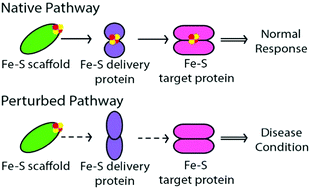当前位置:
X-MOL 学术
›
Metallomics
›
论文详情
Our official English website, www.x-mol.net, welcomes your
feedback! (Note: you will need to create a separate account there.)
Iron–sulfur cluster biosynthesis and trafficking – impact on human disease conditions
Metallomics ( IF 2.9 ) Pub Date : 2017-09-26 00:00:00 , DOI: 10.1039/c7mt00180k C. Wachnowsky 1, 2, 3, 4, 5 , I. Fidai 1, 2, 3, 4, 6 , J. A. Cowan 1, 2, 3, 4, 5
Metallomics ( IF 2.9 ) Pub Date : 2017-09-26 00:00:00 , DOI: 10.1039/c7mt00180k C. Wachnowsky 1, 2, 3, 4, 5 , I. Fidai 1, 2, 3, 4, 6 , J. A. Cowan 1, 2, 3, 4, 5
Affiliation

|
Iron–sulfur clusters (Fe–S) are one of the most ancient, ubiquitous and versatile classes of metal cofactors found in nature. Proteins that contain Fe–S clusters constitute one of the largest families of proteins, with varied functions that include electron transport, regulation of gene expression, substrate binding and activation, radical generation, and, more recently discovered, DNA repair. Research during the past two decades has shown that mitochondria are central to the biogenesis of Fe–S clusters in eukaryotic cells via a conserved cluster assembly machinery (ISC assembly machinery) that also controls the synthesis of Fe–S clusters of cytosolic and nuclear proteins. Several key steps for synthesis and trafficking have been determined for mitochondrial Fe–S clusters, as well as the cytosol (CIA – cytosolic iron–sulfur protein assembly), but detailed mechanisms of cluster biosynthesis, transport, and exchange are not well established. Genetic mutations and the instability of certain steps in the biosynthesis and maturation of mitochondrial, cytosolic and nuclear Fe–S cluster proteins affects overall cellular iron homeostasis and can lead to severe metabolic, systemic, neurological and hematological diseases, often resulting in fatality. In this review we briefly summarize the current molecular understanding of both mitochondrial ISC and CIA assembly machineries, and present a comprehensive overview of various associated inborn human disease states.
中文翻译:

铁硫团簇的生物合成和贩运–对人类疾病的影响
铁硫簇(Fe-S)是自然界中最古老,普遍存在且用途广泛的金属辅因子之一。包含Fe–S簇的蛋白质构成最大的蛋白质家族之一,具有多种功能,包括电子运输,基因表达调控,底物结合和激活,自由基产生,以及最近发现的DNA修复。过去二十年的研究表明,线粒体是真核细胞中Fe–S团簇的生物发生的核心,通过一种保守的簇组装机器(ISC组装机器),它也控制胞质和核蛋白的Fe–S簇的合成。线粒体Fe–S簇以及胞质溶胶(CIA –胞质铁–硫蛋白组装体)已经确定了几个合成和运输的关键步骤,但是簇生物合成,运输和交换的详细机制尚不明确。线粒体,胞质和核Fe–S簇蛋白的生物合成和成熟过程中的遗传突变和某些步骤的不稳定性会影响整个细胞的铁稳态,并可能导致严重的代谢,全身,神经和血液系统疾病,通常导致死亡。在这篇综述中,我们简要总结了当前对线粒体ISC和CIA组装设备的分子理解,
更新日期:2017-10-11
中文翻译:

铁硫团簇的生物合成和贩运–对人类疾病的影响
铁硫簇(Fe-S)是自然界中最古老,普遍存在且用途广泛的金属辅因子之一。包含Fe–S簇的蛋白质构成最大的蛋白质家族之一,具有多种功能,包括电子运输,基因表达调控,底物结合和激活,自由基产生,以及最近发现的DNA修复。过去二十年的研究表明,线粒体是真核细胞中Fe–S团簇的生物发生的核心,通过一种保守的簇组装机器(ISC组装机器),它也控制胞质和核蛋白的Fe–S簇的合成。线粒体Fe–S簇以及胞质溶胶(CIA –胞质铁–硫蛋白组装体)已经确定了几个合成和运输的关键步骤,但是簇生物合成,运输和交换的详细机制尚不明确。线粒体,胞质和核Fe–S簇蛋白的生物合成和成熟过程中的遗传突变和某些步骤的不稳定性会影响整个细胞的铁稳态,并可能导致严重的代谢,全身,神经和血液系统疾病,通常导致死亡。在这篇综述中,我们简要总结了当前对线粒体ISC和CIA组装设备的分子理解,











































 京公网安备 11010802027423号
京公网安备 11010802027423号